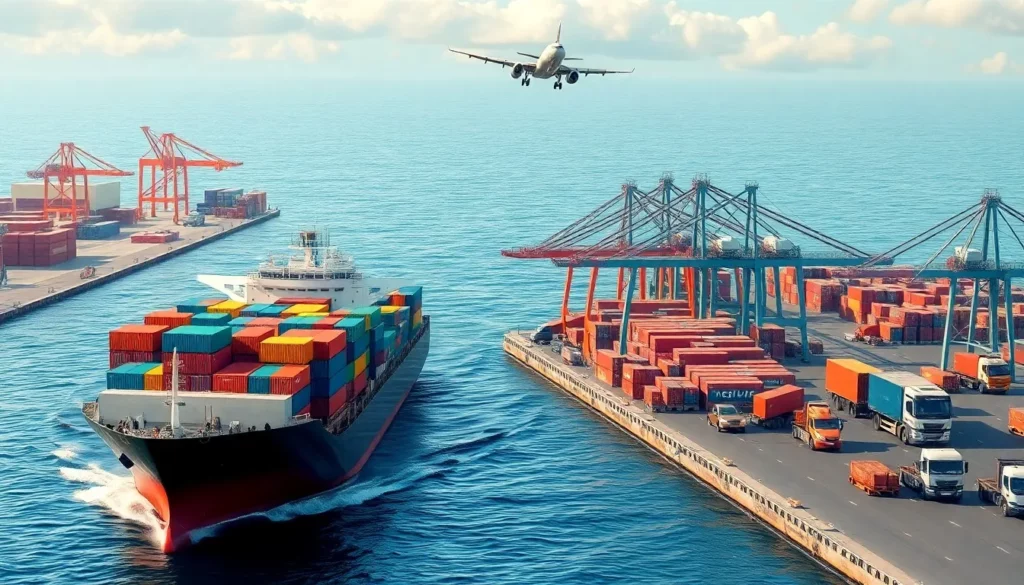The best shipping method from China to Argentina depends on your product volume, budget, and deadlines. This guide provides practical comparisons, cost breakdowns, and expert tips to help you ship efficiently and avoid costly mistakes.
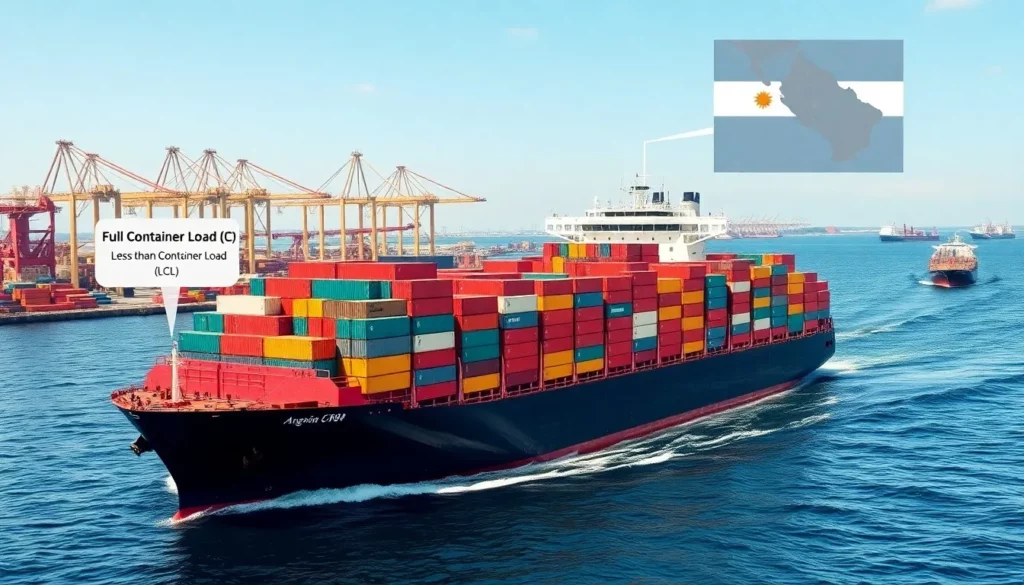
Freight Options
Selecting the right shipping method when importing from China to Argentina can make or break your business. You need to weigh cost, speed, and reliability to align with your supply chain goals. I’ve seen importers thrive by matching their shipping strategy to their product type and timeline—let’s break down your options.
Sea Freight: Your Go-To for Large Volumes and Cost Savings
For businesses moving high volumes, sea freight is the most budget-friendly choice. It’s perfect for non-urgent, bulky goods, and it’s why most B2B importers rely on it for their China-to-Argentina shipments.
Full Container Load (FCL): Exclusive and Secure
With FCL, you get an entire container for your goods. It’s best if your shipment fills at least 70% of a container, offering enhanced security since your cargo isn’t mixed with others. Costs typically range from $2,050-$3,550 for a 20-foot container and $3,050-$5,050 for a 40-foot container.
Less than Container Load (LCL): Flexible for Smaller Shipments
If your shipment is too small for a full container, LCL lets you share space with other shippers. You’ll pay $200-$300 per cubic meter, making it ideal for testing new products or managing limited inventory.
Tip: LCL can be slower due to consolidation, so plan accordingly.
Major Ports and Ocean Routes
Your shipments will likely travel from Chinese ports like Shanghai or Shenzhen to Buenos Aires, Argentina’s busiest port. Other key Argentine ports include Rosario, a hub for agricultural goods, and La Plata. These routes are critical links in the Asia-South America trade network.
Sea Freight Transit Time: Plan for 30-45 Days
Expect port-to-port transit times of 30-45 days for sea freight. This longer timeline requires careful inventory planning to meet customer expectations.
Best practice: Build a buffer into your schedule to account for potential delays.
What Impacts Sea Freight Timelines?
Several factors can extend your delivery window:
- Transshipments: Cargo transfers at intermediate ports can add days.
- Port Congestion: Buenos Aires often sees berthing delays of up to 2 days.
- Weather and Seasons: Storms or peak seasons can disrupt schedules.
Important warning: Monitor port conditions and book early during high-demand periods like Chinese New Year.
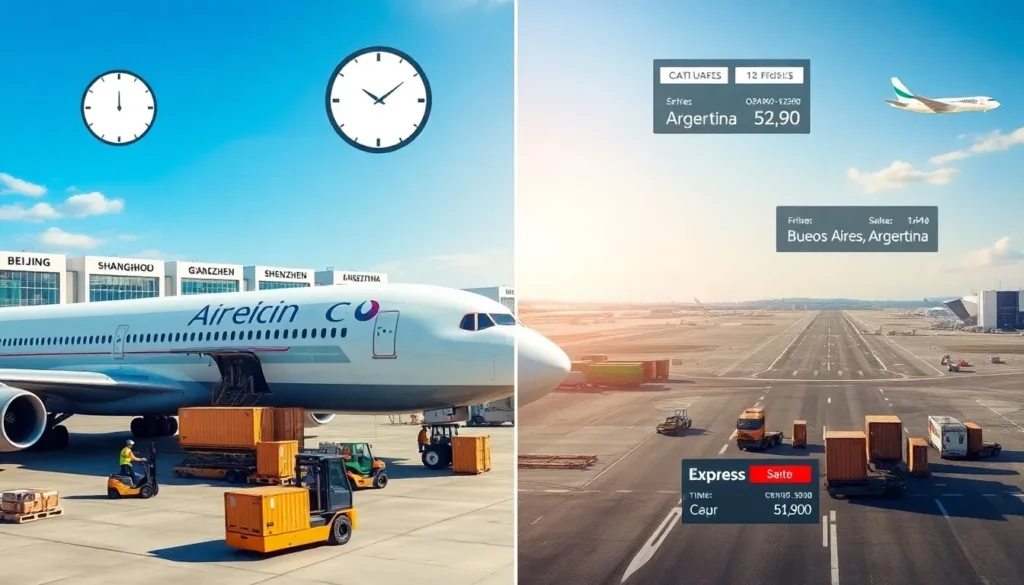
Air Freight: Speed for High-Value or Urgent Goods
When time is critical, air freight delivers your goods from China to Argentina much faster than sea freight. It’s pricier but essential for high-value or time-sensitive shipments like electronics or seasonal items.
Standard vs. Express Air Freight
Standard air freight takes 3-7 days and costs $3-$5 per kilogram, while express services deliver in 1-3 days at $30-$50 per kilogram. Choose based on your urgency and budget.
For example, an importer rushing festival merchandise might opt for express to meet tight deadlines.
Key Air Freight Hubs
Your shipments will likely depart from Beijing, Shanghai, Guangzhou, or Shenzhen and arrive at Buenos Aires, Argentina’s primary air cargo hub. These airports offer robust connectivity and specialized cargo handling.
How Air Freight Costs Are Calculated
Air freight rates, ranging from $6.00-$14.50 per kilogram, depend on the route and chargeable weight (actual or volumetric, whichever is higher). Additional costs like fuel surcharges and handling fees apply.
Tip: Optimize packaging to reduce volumetric weight and save money.
Air Freight Transit Time: 5-10 Days
From airport to airport, air shipments typically take 5-10 days, including customs and handling. This speed makes air freight ideal for urgent restocks or market-sensitive goods.
Best practice: Confirm customs paperwork is ready to avoid clearance delays.

Express Courier Services: Fast and Simple for Small Parcels
For e-commerce businesses or small, high-value items like samples, express couriers offer the fastest door-to-door solution. They’re convenient but come at a premium.
Comparing DHL, FedEx, and UPS
Major carriers provide reliable service:
- DHL: ~$46 per kilogram
- FedEx: ~$44.33 per kilogram
- UPS: ~$41.95 per kilogram (1kg shipments)
Each offers unique strengths in tracking, customs expertise, and delivery networks.
Tip: Compare transit times and surcharges for your specific route.
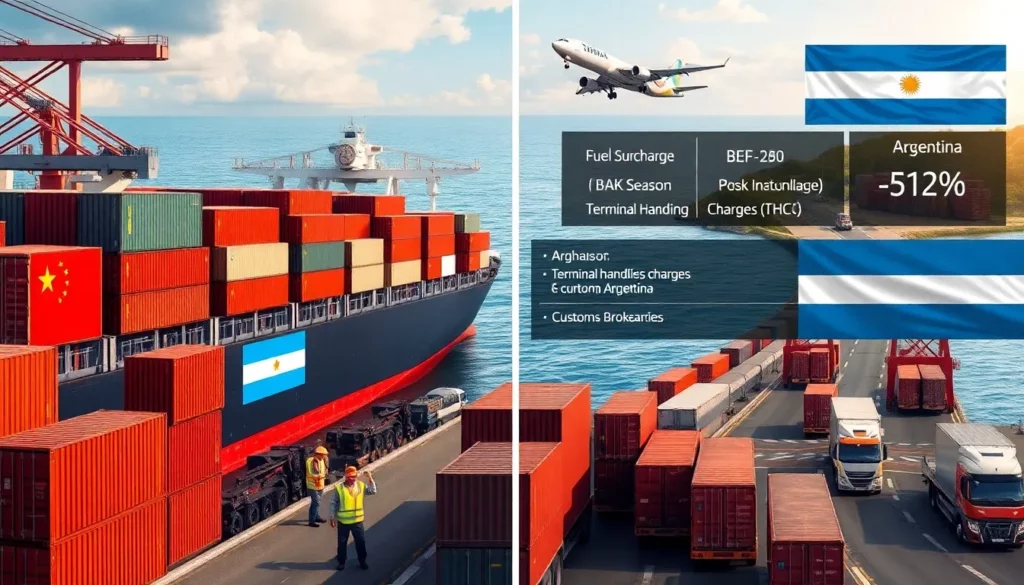
Understanding Your Total Shipping Costs and Argentine Import Duties
To budget accurately, you need a clear picture of all costs involved in shipping from China to Argentina. Freight rates are just the start—additional fees and taxes can significantly impact your bottom line.
Breaking Down Core Freight Charges
Your base freight cost depends on the shipping method. Ocean freight is quoted per container (FCL) or cubic meter (LCL), while air freight is calculated per kilogram with minimum charges for small shipments.
Ocean vs. Air Freight Rate Comparison
| Method | Route | Cost Range |
|---|---|---|
| Ocean (20-ft FCL) | Shanghai to Buenos Aires | $2,800-$3,800 |
| Air Freight | Various Chinese cities | $6.00-$14.50 per kilogram |
The cost difference highlights the trade-off between speed and affordability.
Key takeaway: Choose ocean for bulk, air for urgency.
Surcharges That Add Up
Watch for these common surcharges:
- Fuel Surcharge (BAF): 10-30% of freight cost, tied to oil prices.
- Peak Season Surcharge (PSS): Applies during high-demand periods.
- General Rate Increase (GRI): Periodic carrier adjustments.
Important warning: Budget for surcharges, especially during holidays or market volatility.
Local Charges in China and Argentina
Local fees at origin and destination can account for 20-40% of your total cost. These often catch importers off guard, so factor them in early.
Terminal Handling Charges (THC)
THC covers container loading/unloading at ports:
- China: $100-$300 per container
- Argentina: Higher due to port inefficiencies and labor costs
Tip: Request a breakdown of THC in your quote to avoid surprises.
Inland Transportation Costs
Trucking goods to/from ports varies by distance. In Argentina, costs are higher due to limited infrastructure and economic concentration around Buenos Aires. For instance, moving goods from a rural factory to Shenzhen can be cheaper than trucking from Buenos Aires to inland warehouses.
Customs Brokerage and Agency Fees
Customs brokers in Argentina charge $150-$500 per shipment, with additional documentation fees of $100-$300. Their expertise is critical for navigating complex regulations.
Best practice: Hire a broker with experience in your product category.
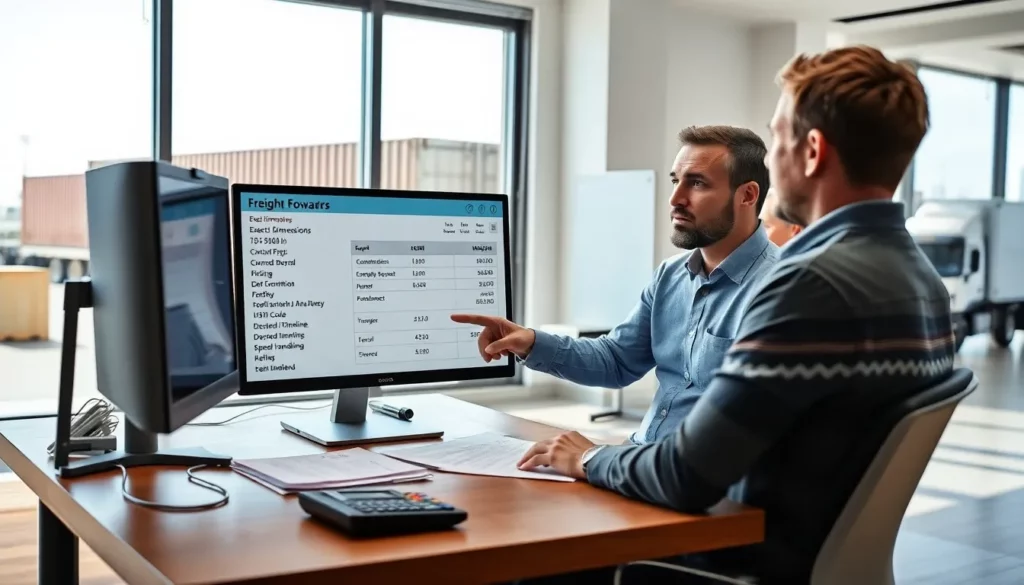
Argentine Import Taxes and Duties Explained
Argentina’s import taxes can significantly inflate your landed cost. You’ll need to account for duties, fees, and VAT to price your goods competitively.
HS Codes and Duty Rates
HS codes determine your duty rates under MERCOSUR’s Common Nomenclature, typically 0-35% of the CIF value. Misclassification can lead to penalties or delays. Important warning: Double-check HS codes with your customs broker.
Argentina’s Customs Valuation
The Argentine customs authority (ARCA) bases duties on the CIF value (Cost, Insurance, Freight). They scrutinize declared values to prevent undervaluation, which can trigger audits.
Tip: Keep detailed records of transaction values to support your declarations.
Duties, Fees, and VAT Breakdown
| Charge | Rate/Details |
|---|---|
| Import Duty | 0-35% of CIF value |
| Statistics Fee | 3% of CIF, capped at $150,000 |
| VAT | 10.5% or 21% + 10-20% advance payment |
| Income Tax Advance | 6% or 11% (if applicable) |
Key takeaway: Work with a broker to calculate these accurately based on your HS codes.
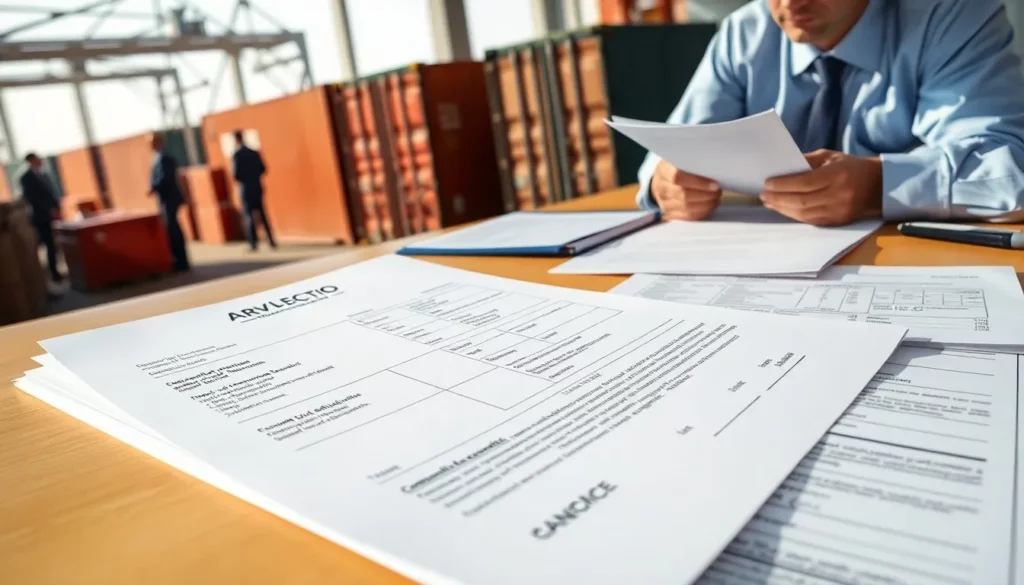
How to Get a Complete Shipping Quote
A detailed quote helps you avoid unexpected costs. Provide your freight forwarder with comprehensive shipment details for precision.
Information Your Freight Forwarder Needs
- Exact dimensions and weight
- Commodity description and HS code
- Pickup and delivery addresses
- Desired timeline
- Special handling requirements
Best practice: Be specific to ensure your quote reflects all charges.
Reviewing Quotes for Hidden Fees
Compare quotes using the same Incoterms (e.g., FOB, CIF). Look for inclusions like customs duties, taxes, or insurance, and flag exclusions that could raise costs.
Key takeaway: A low base rate might hide significant add-ons.

Navigating Argentine Customs Clearance: A Step-by-Step Guide
Argentina’s customs process is complex, but with preparation, you can clear your goods smoothly. Here’s how to avoid delays and penalties.
Step 1: Pre-Shipment Documentation
Accurate documentation is critical to prevent customs holds. Prepare these well before your goods ship.
Required Documents
- Commercial Invoice: Detailed product info, values, HS codes
- Packing List: Itemized contents, dimensions, weights
- Bill of Lading/Air Waybill: Proof of shipment and title
- Certificate of Origin: For preferential duty rates (if applicable)
- Permits/Certifications: For regulated goods like electronics or food
Important warning: Incomplete paperwork is a top cause of delays.
Crafting a Compliant Commercial Invoice
Your invoice must be in Spanish and include:
- Buyer/seller legal names and tax IDs
- Detailed product descriptions matching HS codes
- Country of origin and payment terms
Tip: Accurate values prevent undervaluation penalties.
When You Need a Certificate of Origin
For goods eligible for trade agreement benefits, get a Certificate of Origin from a Chinese chamber of commerce, possibly legalized by the Argentine consulate.
Best practice: Confirm requirements with your broker.
Permits for Regulated Goods
Electronics, food, and pharmaceuticals require specific certifications. For example, an importer of medical devices once faced a week-long delay for missing a safety certificate.
Important warning: Research permit needs early.
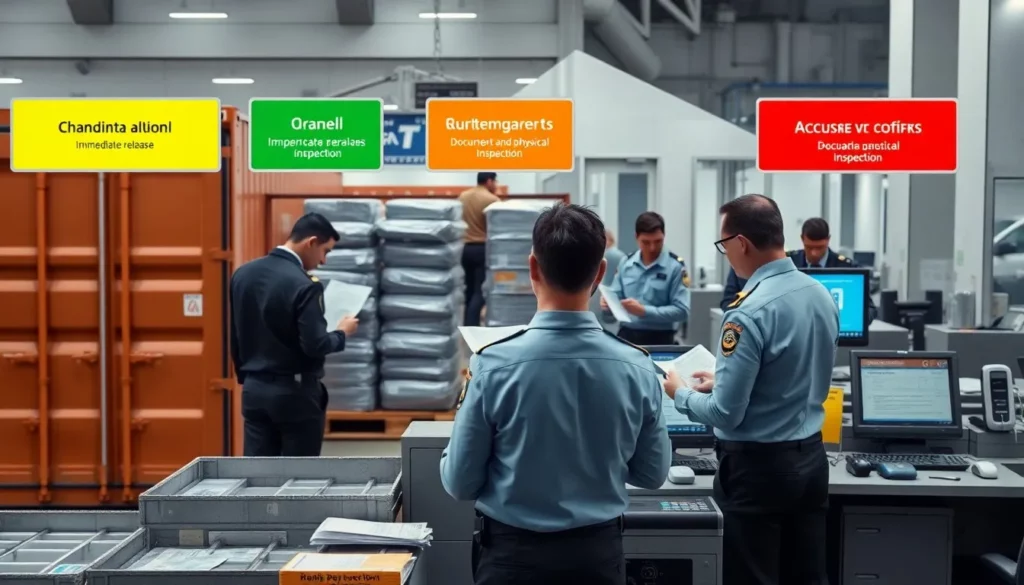
Step 2: The SIMI Import Declaration Process
Argentina’s Comprehensive Import Monitoring System (SIMI) is mandatory for import approvals. Understanding it ensures compliance.
What is SIMI?
SIMI is an electronic platform for processing import licenses, valid for 180 days. You submit declarations free of charge before shipping.
Key takeaway: SIMI approval is non-negotiable.
Your Role as an Importer
You’ll need:
- A CUIT (Unique Tax Identification Code)
- Registration with Argentina’s tax authority
- Fiscal Code Level 3 for SIMI access
Tip: Complete registrations well in advance.
Working with a Customs Broker
A licensed Argentine customs broker handles SIMI submissions, duty calculations, and customs interactions. Their local knowledge is invaluable.
Best practice: Choose a broker familiar with your industry.
Submitting Your SIMI Declaration
Include detailed cargo info (consignee, products, values, HS codes). Cost changes are limited to 7%. Get approval before shipping to avoid rejections.
Important warning: Inaccurate declarations can halt your shipment.
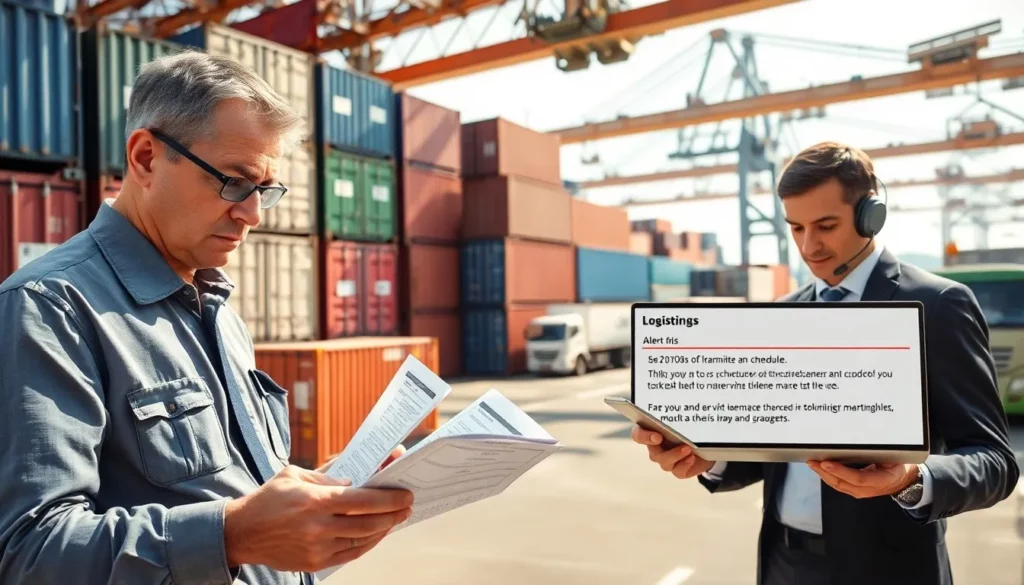
Step 3: Customs Inspection Upon Arrival
Once your goods arrive, they enter Argentina’s clearance process. Knowing what to expect helps you prepare.
Customs Channels
- Green: Immediate release
- Orange: Document review
- Red: Document and physical inspection
Channel assignment depends on risk factors.
Tip: Accurate paperwork reduces red channel risks.
What Triggers Inspections?
Inspections may occur due to:
- Documentation errors
- First-time importer status
- High-risk goods
- Random selection
Important warning: Discrepancies can lead to costly delays.
Customs Verification Process
Officials check quantity, quality, value, and compliance (e.g., labeling). They ensure declared values match transaction records.
Tip: Provide clear, consistent documentation.
Paying Duties and Taxes
Pay duties and taxes electronically via approved banks. Customs releases your goods after confirmation.
Best practice: Budget for taxes upfront to avoid cash flow issues.
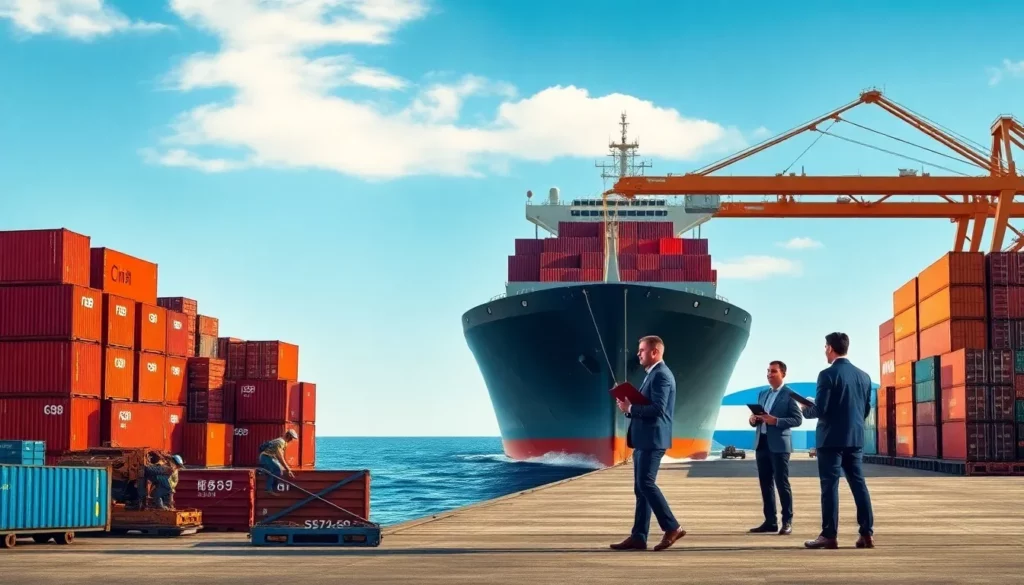
Step 4: Avoiding Customs Delays
Proactive steps minimize clearance issues and keep your supply chain on track.
Common Hold Triggers
- Incorrect valuations
- Inconsistent paperwork
- Missing permits
- SIMI discrepancies
Important warning: Double-check all documents before shipping.
Demurrage and Detention Fees
Demurrage applies for containers left at ports beyond 3-7 days. Detention accrues for unreturned containers. Fees can escalate fast during congestion.
Tip: Monitor free time and plan pickups promptly.
Handling Disputes
If customs questions your declaration, provide supporting documents like contracts or bank records quickly. A broker’s expertise can resolve issues efficiently.
Best practice: Stay responsive to customs inquiries.
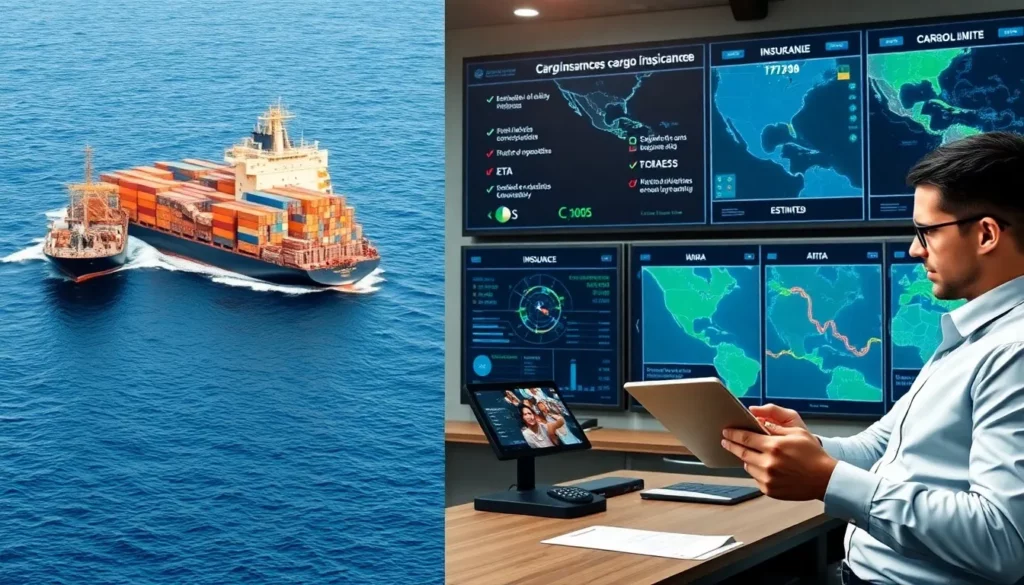
Mitigating Risks for a Seamless Shipment
Shipping from China to Argentina involves risks, but smart strategies protect your goods and budget.
Choosing the Right Incoterms
Incoterms clarify buyer/seller responsibilities. Select terms that suit your control and risk tolerance.
Comparing Key Incoterms
| Incoterm | Seller Responsibility | Buyer Responsibility |
|---|---|---|
| EXW | Factory delivery | All transport and clearance |
| FOB | To port, export clearance | International shipping, import clearance |
| CIF | Shipping and insurance to destination port | Import clearance, local delivery |
| DDP | All costs, including import duties | Final receipt |
Key takeaway: FOB is often best for B2B importers.
Why FOB is Preferred
FOB balances responsibilities. Your Chinese supplier handles local logistics, while you control international shipping for better cost and routing options.
Tip: Use FOB for predictable costs and control.
DDP: Convenience with Caveats
DDP shifts all duties to the seller, but it’s costly and reduces your oversight. Argentina’s complex customs can complicate DDP for sellers.
Important warning: Ensure your supplier understands Argentine regulations if using DDP.
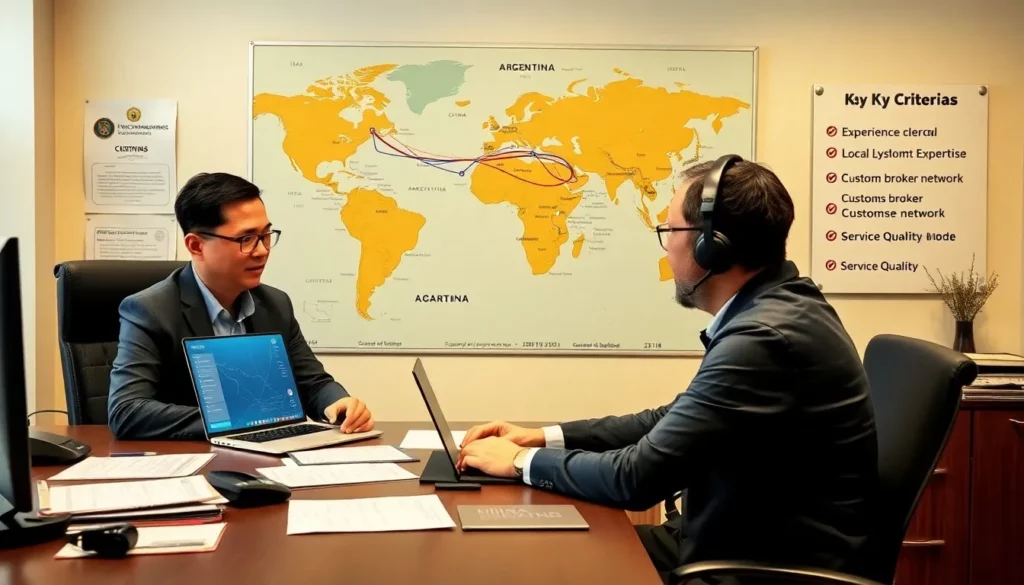
Why Cargo Insurance Matters
Insurance safeguards against transit losses, which carrier liability often doesn’t fully cover.
Carrier Liability vs. All-Risk Insurance
- Carrier Liability: Limited to $3/kg (sea) or $20/kg (air)
- All-Risk Insurance: Covers damage, theft, and accidents
Key takeaway: All-risk insurance is worth the investment.
Calculating Insurance Costs
Premiums are 0.3-0.5% of 110% CIF value. Ensure coverage for handling damage, theft, and weather risks.
Tip: Tailor policies to your goods’ specific risks.
Argentina’s Import Restrictions
Argentina enforces strict rules to protect its market and consumers. Know these to avoid rejections.
Prohibited and Restricted Items
- Prohibited: Fruits, meat, asbestos, radioactive materials
- Restricted: Firearms, narcotics, endangered species
Important warning: Check current regulations via the Argentine consulate.
Labeling and Certification Needs
Goods need Spanish labels with origin and safety info. Electronics, food, and pharmaceuticals require certifications.
Tip: Verify compliance before shipping.
Tracking Your Shipment in Real Time
Real-time tracking keeps you informed and improves customer service.
Using Freight Forwarder Technology
Top forwarders offer platforms with GPS tracking, cargo condition updates, and ETA estimates. User-friendly interfaces let you monitor all shipments easily.
Best practice: Choose a forwarder with robust tracking tools.
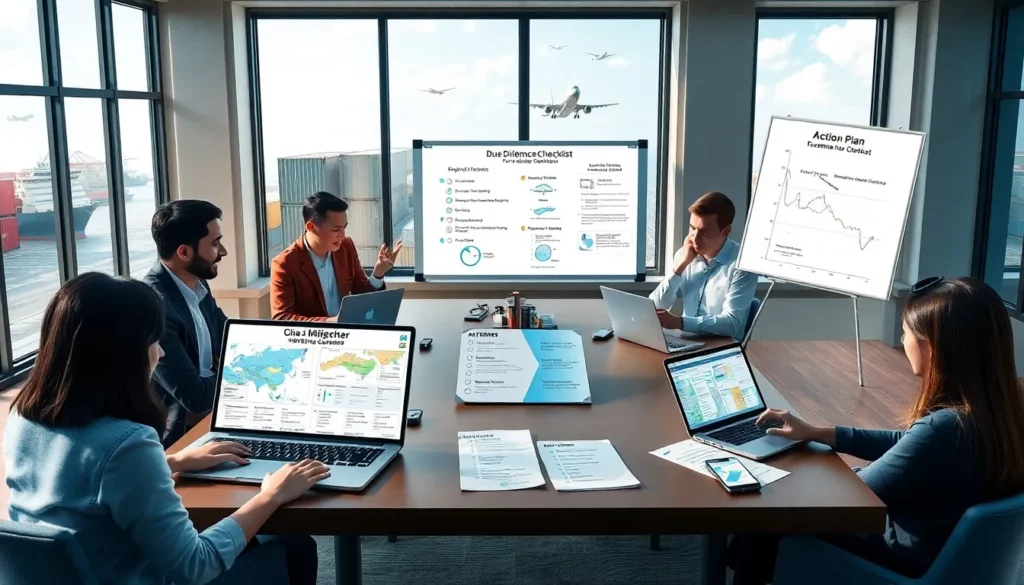
Selecting a Trustworthy Freight Forwarder for Argentina
Your freight forwarder is your partner in success. Choose wisely to streamline your China-to-Argentina shipments.
What to Look for in a Freight Forwarder
Evaluate forwarders based on expertise, networks, and service quality—not just price.
Key Evaluation Criteria
- China-Argentina Experience: Proven track record in this trade lane
- Customs Broker Network: Strong Argentine connections
- Licenses: IATA, FMC, NVOCC, and Chinese qualifications
- Service Quality: Clear communication, fast problem-solving
Key takeaway: Experience and local expertise are non-negotiable.
Experience in the Trade Lane
Ask for case studies or references showing success with similar shipments. I once worked with a forwarder who saved an importer thousands by navigating Buenos Aires’ congestion.
Tip: Verify their familiarity with your product type.
Customs Broker Relationships
A forwarder with licensed Argentine brokers ensures smooth SIMI and clearance processes.
Best practice: Confirm their broker network’s strength.
Necessary Licenses
Ensure your forwarder holds IATA (air), FMC (ocean), and NVOCC certifications, plus Chinese freight forwarding qualifications.
Important warning: Unlicensed forwarders risk delays or fines.
Communication and Responsiveness
Test their responsiveness during quoting. A forwarder who proactively addresses issues is invaluable.
Tip: Prioritize partners who provide regular updates.
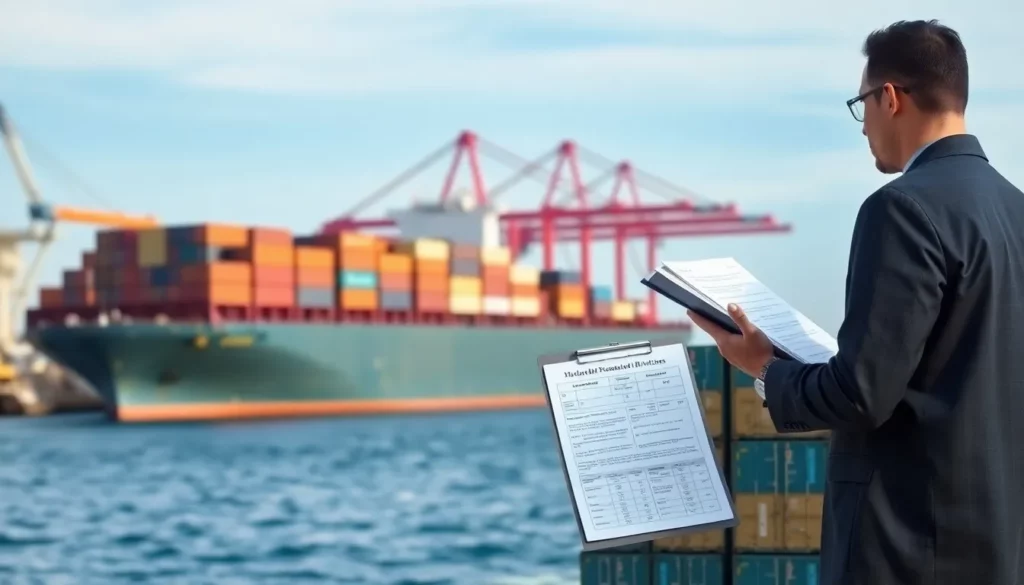
Vetting Your Freight Forwarder
Due diligence ensures reliability. Follow these steps to choose the right partner.
Due Diligence Checklist
- Request client references for similar shipments
- Review case studies of complex China-Argentina logistics
- Test their technology for booking, tracking, and documentation
Best practice: Contact references to gauge satisfaction.
Evaluating Technology Platforms
Look for intuitive systems that offer real-time tracking, electronic document management, and easy booking.
Key takeaway: Modern tech reduces errors and boosts efficiency.
Final Thoughts
Shipping from China to Argentina offers great opportunities but demands careful planning. With the right strategies and partners, you can create a cost-effective, dependable supply chain.
Action Plan for B2B Importers
- Choose Your Method: Sea for volume, air for speed, express for small parcels
- Calculate Costs: Include freight, duties, taxes, and fees
- Prepare Documents: Ensure compliance with SIMI and customs rules
- Select Incoterms: FOB for control, DDP for convenience
- Partner Wisely: Pick a forwarder with China-Argentina expertise
Key takeaway: Thorough preparation and strong partnerships drive success.
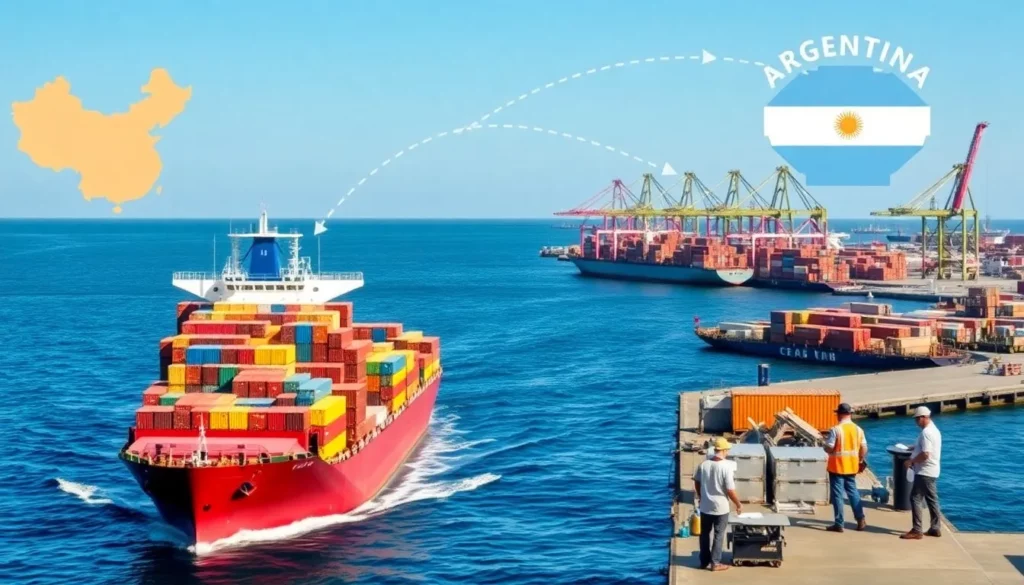
Frequently Asked Questions (FAQs)
1. How Long Does Sea Freight Take from China to Argentina?
Port-to-port transit takes 30-45 days, depending on routes, transshipments, and port schedules. Add time for inland transport and customs.
Tip: Plan for buffers during peak seasons.
2. What Documents Are Needed for Argentine Customs?
You’ll need a commercial invoice (in Spanish), packing list, Bill of Lading/Air Waybill, SIMI approval, and possibly a Certificate of Origin or permits.
Important warning: Missing documents cause delays.
3. How Do I Calculate Import Duties and Taxes?
Use the CIF value, apply HS code-based duties (0-35%), add a 3% statistics fee (capped at $150,000), VAT (10.5% or 21% + advance), and income tax (6% or 11% if applicable).
Best practice: Consult a broker for accuracy.
4. What’s the Difference Between a Freight Forwarder and a Customs Broker?
A forwarder manages international logistics, while a customs broker handles Argentine clearance, including SIMI and duty calculations.
Key takeaway: Both are essential for smooth imports.
5. How Can I Avoid Customs Delays in Argentina?
Ensure accurate, consistent documentation, obtain SIMI approval pre-shipment, use correct HS codes, and secure permits. Work with experienced brokers and forwarders.
Important warning: Errors trigger inspections and fees.

